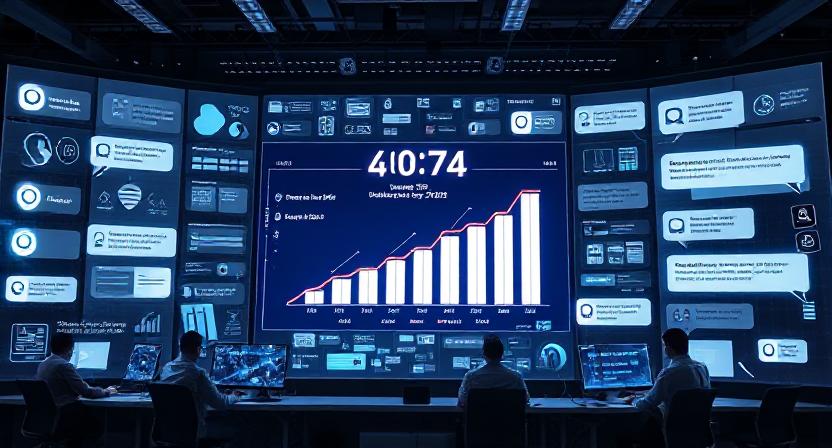78% of Organizations Now Use AI to McKinsey

Enterprise AI Adoption Hits 78% in 2024 According to Gartner 78% of organizations reported using AI in at least one business function in 2024 up...
⏱️ Estimated reading time: 5 min
Latest News
Enterprise AI Adoption Hits 78% in 2024
According to Gartner 78% of organizations reported using AI in at least one business function in 2024 up from 72% earlier in the year and just 55% in 2022 . This meteoric rise underscores AI’s rapid normalization across business operations. Let’s explore the significance of this number the implications for the near future and how organizations can navigate the evolving AI landscape.
Why 78% Matters for Enterprise AI Adoption
Reaching 78% adoption signals that AI has become far more than a buzzword it’s now embedded in everyday business functions. Gartner data shows organizations are applying AI in areas including IT marketing sales and service operations . More than just an experimental phase AI is being activated across operational processes and increasingly at strategic levels.
The Rise of AI Pilots
Notably as AI adoption scales many organizations are moving swiftly from pilot stages to full production.
In fact over 55% of firms report either piloting or deploying AI in production particularly in areas like development customer service and marketing.
Moreover a LangChain survey revealed that 63% of mid-sized companies already run AI agents in production environments with non-tech businesses adopting at nearly the same rate as tech firms.
Growing Risks and Failures
However not all AI projects succeed. Gartner warns that up to 30% of generative AI projects may be abandoned by 2025 often for reasons such as data issues cost overruns, or insufficient business value Technology Magazine. This highlights the need for effective governance data readiness and alignment with business goals.

Strategic Implications: What’s Coming Next
Notably Gartner forecasts that by 2024 40% of enterprise applications will embed conversational AI-up sharply from under 5% in 2020.
This underscores how AI has shifted from experimental pilots to core features in enterprise software-transforming workflows and raising user expectations.
Automation & Agentic AI Rise
Looking ahead Gartner predicts agentic AI autonomous AI that can act without human prompts will become much more pervasive. By 2028 it’s expected to handle 15% of everyday business decisions and 33% of enterprise applications will incorporate agentic capabilities . However current data shows many organizations lack the readiness to deploy such systems due largely to data silos and immature infrastructure .
Spending Soars on Hardware and Infrastructure
A key insight from Gartner is the massive investment in AI infrastructure. In 2025 global spending on generative AI is forecast to reach $644 billion with 80% of that going toward hardware including AI-capable devices and chips. Organizations must therefore rethink budgets to account for substantial infrastructure costs not just software licenses.
What Organizations Must Do Now
Moreover many AI initiatives falter due to poor data quality or unclear ROI making data readiness and strong governance frameworks essential priorities for enterprises.
Move Beyond Pilots to Scale
AI adoption should evolve beyond single-use cases. Gartner’s insights on low completion rates and high abandonment highlight the importance of strategic scaling plans not just experimentation.
Embed AI, Don’t Bolt It On
Given the move toward embedded AI organizations should plan to integrate AI into core business systems like CRM and ERP rather than adopting standalone tools. Look for platforms with AI as a native capability.
Prepare for Autonomous AI
Specifically agentic AI demands a robust architecture organizations need unified data systems centralized governance and orchestrated control to avoid siloed deployments that undermine effectiveness.
Invest Wisely in Infrastructure
Specifically plan your tech budget to support escalating AI workloads by investing in AI-capable hardware especially for inference-heavy deployments.
For example infrastructure typically consumes 30–40% of total AI spending while hardware and tech upgrades alone can account for 15–30% of the initial investment.MonetizelyBytePlus
Moreover an upgraded infrastructure isn’t optional organizations must optimize performance cost-efficiency scalability and privacy across CPUs GPUs DPUs and network elements.
What’s at Stake: The Long-Term View
Business Transformation
With deep AI adoption comes transformative potential. Sectors like customer service supply chain and marketing are being reshaped. Enterprises that lead AI integration stand to gain substantial efficiency innovation and competitive edge.
New Skill Demand
Notably as AI adoption deepens, organizations now require strategic roles such as AI Ethics Officers ML Engineers and Data Scientists to guide responsible innovation and scalable deployment.
Accordingly companies are investing in reskilling programs and internal AI Centers of Excellence to build in-house expertise and contextual governance.
Governance & Trust
Notably AI’s rise brings important ethical and trust considerations that organizations cannot overlook.
According to Gartner frameworks like AI Trust Risk and Security Management AI TRiSM are becoming essential for ensuring AI systems operate reliably ethically and securely
Consequently transparency continuous monitoring, and compliance must remain foundational pillars in responsible AI deployment.
Conclusion
Gartner’s leap to 78% enterprise AI adoption in 2024 marks a watershed in the AI journey. AI is no longer emerging it’s everywhere. This brings tremendous opportunity, from productivity gains to embedded intelligent systems. Yet the path forward demands maturity strong data foundations risk-aware scaling and strategic investment in infrastructure.For organizations poised to lead the time is now. Embrace AI not just as a tool but as a core pillar of digital transformation.
Related Posts

Share Your AI Gems: Google Gemini’s New Feature
Google Gemini’s Gems: Share Your Custom AI Assistants Google now empowers you to share your...
September 18, 2025

Justice and AI Fairness Costs Under UNESCO Spotlight
Balancing Fairness and Public Safety in AI Judgment Systems New Academic Findings Artificial intelligence is...
September 12, 2025

Justice System AI Fairness Costs Revisited by UNESCO
AI in Criminal Justice Balancing Fairness and Public Safety Artificial intelligence AI has become an...
September 11, 2025











Leave a Reply